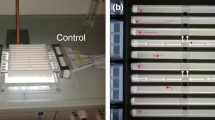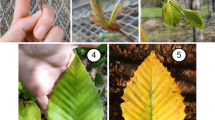Abstract
Biological activity and chemistry of host plant volatiles were investigated for Diorhabda elongata, Brullé (Coleoptera: Chrysomelidae), a biological control agent for the invasive tree, saltcedar (Tamarix spp., Tamaricaceae). Gas chromatographic–electroantennographic detection (GC-EAD) analysis of volatiles collected from adult D. elongata feeding on saltcedar foliage or from saltcedar foliage alone showed 15 antennally active compounds. These compounds were more abundant in collections from beetle-infested foliage. Antennally active compounds were identified by GC–mass spectrometry (MS) and confirmed with authentic standards. The emissions of the most abundant GC-EAD-active compounds, green leaf volatiles (GLV), were quantitated by GC-MS. A blend of four GLV compounds, mimicking the natural blend ratio, was highly attractive to male and female D. elongata in the field, and a combination of GLV and male-produced aggregation pheromone attracted significantly greater numbers of D. elongata than did either bait alone. A preliminary experiment with a blend of seven additional GC-EAD-active saltcedar volatiles did not show any behavioral activity. The combination of the pheromone and the green leaf odor blend could be a useful attractant in detecting the presence of the biocontrol agent, D. elongata, in stands of saltcedar newly colonized by the beetle.


Similar content being viewed by others
References
Andersen, J. F. and Metcalf, R. L. 1986. Identification of a volatile attractant for Diabrotica and Acalymma species from the blossoms of Cucurbita maxima Duchesne. J. Chem. Ecol. 12:687–699.
Bartelt, R. J. 1999. Sap beetles, pp. 69–89, in J. Hardie and A. K. Minks (eds.). Pheromones of Non-Lepidopteran Insects Associated with Agricultural Plants. CABI Publishing, Wallingford.
Bartelt, R. J. and Zilkowski, B. W. 1999. Nonequilibrium quantitation of volatiles in air streams by solid-phase microextraction. Anal. Chem. 71:92–101.
Borden, J. H. 1985. Aggregation pheromones, pp. 257–285, in G. A. Kerkut and L. I. Gilbert (eds.). Comprehensive Insect Physiology and Pharmacology, Vol. 9. Pergamon Press, Oxford.
Cossé, A. A. and Bartelt, R. J. 2000. Male-produced aggregation pheromone of Colopterus truncatus: structure, electrophysiological and behavioral activity. J. Chem. Ecol. 26:1735–1748.
Cossé, A. A., Bartelt, R. J., and Zilkowski, B. W. 2002. Identification and electrophysiological activity of a novel hydroxy ketone emitted by male cereal leaf beetle. J. Nat. Prod. 65:1156–1160.
Cossé, A. A., Bartelt, R. J., Zilkowski, B. W., Bean, D. W., and Petroski, R. J. 2005. The aggregation pheromone of Diorhabda elongata, a biological control agent of saltcedar (Tamarix spp.): identification of two behaviorally active components. J. Chem. Ecol. 31:657–670.
DeLoach, C. J., Lewis, P. A., Carruthers, R. I., Herr, J. C., Tracy, J. L., and Johnson, J. 2003. Host specificity of a leaf beetle, Diorhabda elongata (Coleoptera: Chrysomelidae) from Asia, for biological control of saltcedars (Tamarix: Tamaricaceae) in the western United States. Biol. Control 27:117–147.
DeLoach, C. J., Carruthers, R., Dudley, T., Eberts, D., Kazmer, D., Knutson, A., Bean, D., Knight, J., Lewis, P., Tracy, J., Herr, J., Abbot, G., Prestwich, S., Adams, G., Mityaev, I., Jashenko, R., Li, B., Sobhian, R., Kirk, A., Robbins, T., and Delfosse, E. 2004. First results for control of saltcedar (Tamarix spp.) in the open field in the western United States. Eleventh International Symposium on Biological Control of Weeds, Canberra, Australia.
Dicke, M. and van Loon, J. A. 2000. Multitrophic effects of herbivore-induced plant volatiles in an evolutionary context. Entomol. Exp. Appl. 97:237–249.
Dicke, M. and Vet, L. E. M. 1999. Plant–carnivore interactions: evolutionary and ecological consequences for plant, herbivore, and carnivore, pp. 483–520, in H. Olff, V. K. Brown, and R. H. Drent (eds.). Herbivores: Between Plants and Predators. Blackwell Science, Oxford.
Dicke, M., Takabayashi, J., Posthumus, M. A., Schütte, C., and Krips, O. E. 1998. Plant–phytoseiid interactions mediated by herbivore-induced plant volatiles: variation in production of cues and in responses of predatory mites. Exp. Appl. Acarol. 22:311–333.
Dickens, J. C. 1999. Predator–prey interactions: olfactory adaptations of generalist and specialist predators. Agric. For. Entomol. 1:47–54.
Dickens, J. C. 2000. Orientation of Colorado potato beetle to natural and synthetic blends of volatiles emitted by potato plants. Agric. For. Entomol. 2:167–172.
Dickens, J. C. 2006. Plant volatiles moderate response to aggregation pheromone in Colorado potato beetle. J. Appl. Entomol. 130:26–31.
Dickens, J. C., Jang, E. B., Light, D. M., and Alford, A. R. 1990. Enhancement of insect pheromone response by green leaf volatiles. Naturwissenschaften 77:29–31.
Ephrussi, B. and Beadle, G. W. 1936. A technique of transplantation for Drosophila. Am. Nat. 70:218–225.
Friedman, J. M., Auble, G. T., Shafroth, P. B., Scott, M. L., Merigliano, M. F., Freehling, M. D., and Griffin, E. R. 2005. Dominance of non-native riparian trees in western USA. Biol. Invasions 7:747–751.
Lampman, R. L., Metcalf, R. L., and Andersen, J. F. 1987. Semiochemical attractants of Diabrotica undecimpunctata howardi Barber, southern corn rootworm, and Diabrotica virgifera virgifera LeConte, the western corn rootworm (Coleoptera: Chrysomelidae). J. Chem. Ecol. 13:959–975.
Lewis, P. A., DeLoach, C. J., Knutson, A. E., and Tracy, J. L. 2003. Biology of Diorhabda elongata (Coleoptera: Chrysomelidae), an Asian leaf beetle for biological control of saltcedars (Tamarix spp.) in the United States. Biol. Control 27:101–116.
Metcalf, R. L. and Metcalf, E. R. 1992. Plant Kairomones in Insect Ecology and Control. Chapman and Hall, New York, NY.
Petroski, R. J. 2003. Straightforward preparation of (2E,4Z)-2,4-heptadien-1-ol and (2E,4Z)-2,4-heptadienal. Synth. Commun. 33:3233–3241.
Rao, S., Cossé, A. A., Zilkowski, B. W., and Bartelt, R. J. 2003. Aggregation pheromone of the cereal leaf beetle: field evaluation and emission from males in the laboratory. J. Chem. Ecol. 29:2165–2175.
Reinecke, A., Ruther, J., and Hilker, M. 2005. Electrophysiological and behavioral responses of Melolontha melolontha to saturated and unsaturated aliphatic alcohols. Entomol. Exp. Appl. 115:33–40.
Ruther, J. and Mayer, C. J. 2005. Response of garden chafer, Phyllopertha horticola, to plant volatiles: from screening to application. Entomol. Exp. Appl. 115:51–59.
Shafroth, P. B., Cleverly, J. R., Dudley, T. L., Taylor, J. P., Van Riper, C., Weeks, E. P., and Stuart, J. N. 2005. Control of Tamarix in the western United States: implications for water salvage, wildlife use, and riparian restoration. Environ. Manage. 35:231–246.
Soroka, J. J., Bartelt, R. J., Zilkowski, B. W., and Cossé, A. A. 2005. Responses of flea beetle Phyllotreta cruciferae to synthetic aggregation pheromone components and host plant volatiles in field trials. J. Chem. Ecol. 31:1829–1843.
TÓth, M., Csonka, E., Bartelt, R. J., Cossé, A. A., Zilkowski, B. W., Muto, S., and Mori, K. 2005. Pheromonal activity of compounds identified from male Phyllotreta cruciferae: field tests of racemic mixtures, pure enantiomers, and combinations with allyl isothiocyanate. J. Chem. Ecol. 31:2705–2720.
Visser, J. H. 1986. Host odor perception in phytophagous insects. Annu. Rev. Entomol. 31:121–144.
Visser, J. H. and Avé, D. A. 1978. General green leaf volatiles in the olfactory orientation of Colorado beetle, Leptinotarsa decemlineata. Entomol. Exp. Appl. 24:738–749.
Wiley Spectral Library. 1995. 6th edition, CD-ROM. John Wiley and Sons, New York, NY.
Zavaleta, E. 2000. The economic value of controlling an invasive shrub. Ambio 29:462–467.
Author information
Authors and Affiliations
Corresponding author
Additional information
Mention of trade names or commercial products in this article is solely for the purpose of providing specific information and does not imply recommendation or endorsement by the U.S. Department of Agriculture.
Rights and permissions
About this article
Cite this article
Cossé, A.A., Bartelt, R.J., Zilkowski, B.W. et al. Behaviorally Active Green Leaf Volatiles for Monitoring the Leaf Beetle, Diorhabda elongata, a Biocontrol Agent of Saltcedar, Tamarix spp.. J Chem Ecol 32, 2695–2708 (2006). https://doi.org/10.1007/s10886-006-9193-x
Published:
Issue Date:
DOI: https://doi.org/10.1007/s10886-006-9193-x




